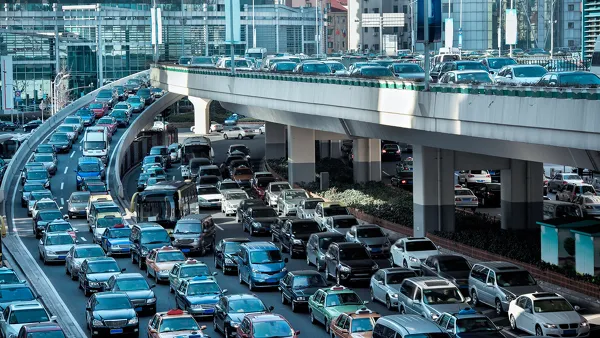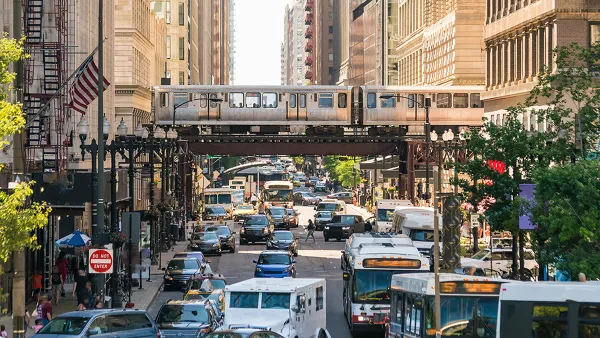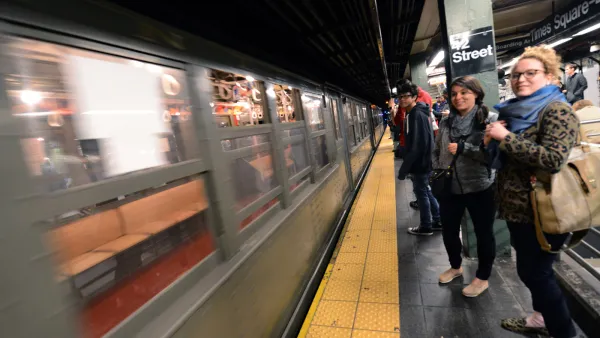According to the Census Bureau's American Community Survey on commuting to work, one subregion in the Bay Area can claim accolades for having achieved the largest drop in solo-commuting from 2006, scoring the third lowest drive-alone rate in 2013.
"Workers in the San Francisco Bay Area made the nation’s most dramatic shift from commuting via automobile to using alternative transportation between 2006 and 2013, according to a new Census Bureau report," writes Dan Walters in a Capitol Alert for The Sacramento Bee on the Census report released Thursday, August 13.
The San Francisco-Oakland-Hayward, CA metropolitan statistical area (MSA) had the third lowest rate of solo commuting in 2012 at 69.8 percent, as listed in Table 2 on page 6 of 28 [PDF] behind:
- New York-Newark-Jersey City, NY-NJ-PA: 56.9%
- Ithaca, NY: 68.7%
Compare those figures with the national drive-alone rate of 76.4 percent. However, the San Francisco MSA achieved the highest rate of decrease of solo auto commuting at 3.8%, listed on Table on page 5, followed by the MSAs of:
- Boston-Cambridge-Newton, MA-NH: 3.3%
- Durham-Chapel Hill, NC: 2.9%
Bicycling was the least popular method of commuting, used by just six-tenths of one percent of workers.
More evidence of peak car?
While the 76.4 percent drive-alone rate in 2013 is high, the press release states that "driving alone to work peaked in 2010 at 76.6 percent.
"In recent years, the percentage of workers who commute by private vehicle remained relatively stable after decades of consistent increase," writes the report's author, Brian Mckenzie, in the introduction. "For several individual years since the mid-2000s, the average number of vehicle miles traveled [VMT] in the United States has either increased at a slower pace than in previous decades or declined."
Although such shifts in travel behavior are slight, they have captured attention because they represent a disruption in an unequivocal, decades-long pattern of increased automobile travel.
Carpooling decline leads to auto commute decline
"Overall, automobile commuting has declined since 2000, in part, due to the continuation of a long-standing pattern of a decline in carpooling," notes McKenzie in a Random Samplings blog" on urban millennial commute choices.
One out of five U.S. workers carpooled in 1980, but in 2013, only one out of 10 carpooled.
McKenzie cites four 2014 research papers from the prolific Michael Sivak of the University of Michigan Transportation Research Institute (UMTRI) that ask, "Has motorization in the U.S. Peaked?"
FULL STORY: SF Bay Area commuters make big shift away from cars

Analysis: Cybertruck Fatality Rate Far Exceeds That of Ford Pinto
The Tesla Cybertruck was recalled seven times last year.

National Parks Layoffs Will Cause Communities to Lose Billions
Thousands of essential park workers were laid off this week, just before the busy spring break season.

Retro-silient?: America’s First “Eco-burb,” The Woodlands Turns 50
A master-planned community north of Houston offers lessons on green infrastructure and resilient design, but falls short of its founder’s lofty affordability and walkability goals.

Test News Post 1
This is a summary

Analysis: Cybertruck Fatality Rate Far Exceeds That of Ford Pinto
The Tesla Cybertruck was recalled seven times last year.

Test News Headline 46
Test for the image on the front page.
Urban Design for Planners 1: Software Tools
This six-course series explores essential urban design concepts using open source software and equips planners with the tools they need to participate fully in the urban design process.
Planning for Universal Design
Learn the tools for implementing Universal Design in planning regulations.
EMC Planning Group, Inc.
Planetizen
Planetizen
Mpact (formerly Rail~Volution)
Great Falls Development Authority, Inc.
HUDs Office of Policy Development and Research
NYU Wagner Graduate School of Public Service




























